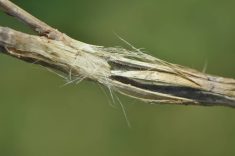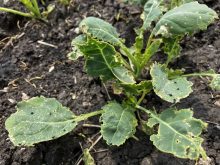Combining faster cuts harvesting costs, but can also result in higher grain loses, says Les Hill, manager of agricultural technical services at the Prairie Agricultural Machinery Institute (PAMI) in Humboldt, Sask.
We know it s all balance, Hill said Sept. 9 during a webinar for the Canola Council of Canada on maximizing canola harvesting. When you re running your combine and adjusting you re trying to find that magic balance between profit and productivity.
Harvesting faster reduces the fixed cost per bushel. In one example, Hill said increasing the combine speed to five miles an hour from four would save $160 on 150 acres of canola and cut the combining time by two hours.
Read Also

Manitoba sclerotinia picture mixed for 2025
Variations in weather and crop development in this year’s Manitoba canola fields make blanket sclerotinia outlooks hard to pin down
However, if that extra one-mile per hour resulted in half a bushel loss per acre, the farmer would forego $750 for a net loss of $120 with canola at $10 a bushel. If faster speeds result in losses of one, two, three or more bushels an acre, the cost will be more significant, Hill said.
A three-bushel an acre loss on that 150-acre field totals $4,500. Knock off the saving from faster combining and the farmer is still out $3,870 on that 150-acre field, or almost $26 an acre.
STARTS WITH THE SWATH
Getting the most from a combine starts with a good swath, Hill said.
Uniformity is extremely important the reason being any time you get breaks in the swath… your combine is going from underloading to an overload condition.
Crop should enter the combine head-first. Sometimes canola gets pushed the opposite way by the roller following the swather. Feeding the combine evenly starts at the pickup and carries through the machine.
Weathered canola is easier to thresh as the pods open easier, Hill said. Ideally the process of separating the seed from the chaff will begin right away. The biggest factor affecting separation is MOG material other than grain such as straw. Reducing the straw that goes in the combine by swathing higher increases the operating capacity, Hill said.
With bigger combines the trend has been wider swaths, but the inlet on rotary combines, especially single-axial rotary ones, is small. For those it s better to have a narrower swath and travel faster, Hill said. With a conventional or dual rotary combine it s better to have a wider or dual swath.
ADJUSTMENTS
When adjusting your combine the initial combine settings should be as follows:
” Cylinder the highest setting.
” Concave the smallest setting.
” Pre-cleaner the smallest setting.
” Chaffer sieve the largest opening.
” Tailings sieve mid range.
” Cleaning sieve the largest setting.
To fine-tune the fan get the combine driver to go one mile an hour and bump up the fan speed until a few seeds start to blow over. Then start running at a normal speed and check the combine s performance. The straw chopper should disengaged allowing the straw to drop straight behind the combine. Use a pan to collect what comes out and a screen and portable blower to remove the chaff. The collected seeds can be weighed, placed in a graduated vial, measured in the pan or counted to determine the bushels being lost per acre. The canola council s web-site has charts to make the conversion.
Always go back and think about the basics, Hill said. Make only one adjustment at a time and see what happens. If you start making too many adjustments at one time and it doesn t work you get very frustrated. You don t know which one made it better and which one made it worse.
It s a trade-off when it comes to the threshing. If threshing is too aggressive seeds are damaged, but if it s not aggressive enough seed is left in pods or plant head.
The problem with damaged kernels is usually you ll only find about half of what really is occurring in the grain tank because the other half usually blows out, Hill said.
To increase threshing, speed up the cylinder, reduce the concave clearance or as a last resort reduce ground speed. If seed is damaged, increase the ground speed if losses aren t significant, reduce cylinder speed or reduce concave clearance.
If free grain is discharged over the separator increase the cylinder speed or reduce the concave clearance or slow down. Dockage only takes away from its own weight so it s really not a penalty, but seed when you get it very clean and you start blowing it out that loss never gets to market and that costs you big time so you have to think about the balance there, Hill said. If it means saving the seed take a little dirtier sample.
———
Youwanttohave asuniformofaflow aspossibleallthe waythrough.
LES HILL



















